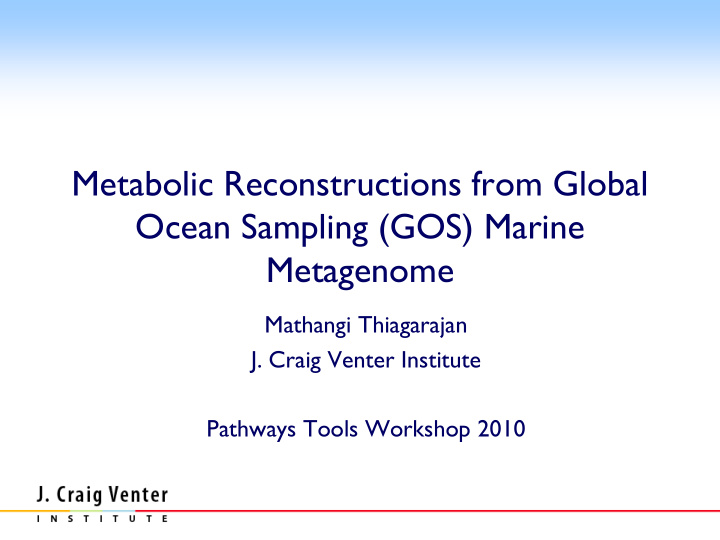



Metabolic Reconstructions from Global Ocean Sampling (GOS) Marine Metagenome Mathangi Thiagarajan J. Craig Venter Institute Pathways Tools Workshop 2010
Metagenomics The Global Ocean Sampling (GOS) Project GOS - Community Makeup High Throughput Data Processing Metabolic Reconstruction – Mapping to MetaCyc and KEGG Metarep (Visualization) – Integrating with MetaCyc and KEGG Pathways Tools for GOS & metagenomic projects Conclusion Acknowledgements
Metagenomics Examining genomic content of organisms in community/environment to better understand Diversity of organisms Their roles and interactions in the ecosystem Cultivation independent approach to study microbial communities DNA directly isolated from environmental sample and sequenced
Global Ocean Sampling Expedition Investigate the fundamental microbial contributions from the Ocean waters to energy and nutrient cycling by analyzing its a) biogeochemical cycling b) community structure and function c) microbial diversity d) adaptation and evolution GOS Phase I - Published in PLOS Biology 2007 GOS Circumnavigation - Analysis Phase
Global Ocean Sampling Expedition Route
Sample Filtration
GOS circumnavigation data 229 stations and 291 samples 0.1µm 0.8µm viral 3.0µm
GOS data Reads Proteins Sequencing Technology Phase I 7.6 Million 9.8 Million Sanger Circumnavigation 48 Million ~53Million Sanger + 454
GOS dataset is expanding the protein universe GOS genes NCBI genes 8 7 6 Million genes 5 Million genes GOS 4 3 GOS 2 NCBI 1 NCBI 0 2004 2007 Extrapolation based on amount of GOS sequence data currently available but not yet released to public domain
Community makeup
Taxonomic makeup of GOS samples based on 16S data from shotgun sequencing
Phylogenetic Distribution in the Indian Ocean across size-classes 0.1 µm 0.8 µm 3.0 µm Synechococcus sp. Bacteroidetes ds DNA viruses Verrucomicrobia Planctomycetes
GOS increases size and diversity of known protein families GOS: prokaryote ryotes , eukaryote ryotes Known: prokary ryote tes , eukary ryote tes RuBisCO Glutamine synthetase (type II)
Viruses in the Marine Environment Abundant: ~10 7 /ml -1 of surface seawater Diverse: VBR 10 ; ~ 10-fold greater diversity than microbial hosts Influence microbial diversity through infection and host cell lysis Mediators of horizontal gene transfer Influence biogeochemical cycling, particularly carbon
High-throughput Metagenomic Data Analysis Annotation Pipeline Linking to Metadata -Structural Annotation (coding + non coding -Functional Annotation Sample Comparison -Taxonomic level -DNA library level Protein Clustering Metagenomic -Protein level -Functional and Data Processing metabolic profiles & Analysis Taxonomic Classification Functional linkages via Operons Fragment Recruitment Metabolic Reconstruction Metagenomic Assembly -Sanger data -454 data - Illumina data (HMP)
Metagenomic Data Processing - Annotation pipeline Structural Annotation Functional Annotation Published in SIGS
Annotation Rules Hierarchy
Viral Metagenomic (functional)Pipeline 19
Annotation Rules Hierarchy (Viral) PFAM/TIGRFAM_HMM, equivalog above trusted cutoff ACLAME_PEP, %id>= 50, coverage >= 80, e-value <= 10 -10 ALLGROUP_PEP, %id>= 50, coverage >= 80, e-value <= 10 -10 ACCLAME_HMM matches, > 90% coverage, e-value < 10 -5 PFAM/TIGRFAM_HMM, non-equivalog above trusted cutoff CDD_RPS, %id>= 35%, coverage >= 90% of CDD-domain, e-value <= 1e -10 FRAG_HMM, e-value < 1e -5 ACLAME_PEP, %id >= 30%, coverage >= 70%, e-value <= 1e -5 ALLGROUP_PEP, %id >= 30%, coverage >= 70%, e-value <= 1e -5 No evidence -> hypothetical protein 20
Metagenomic Assembly Advantages Challenges Provides genomic context Coverage dependent Reduces redundancy and Variation can limit the complexity length of assemblies Improves annotation Can mask diversity Mechanism to isolate environment specific gene regions • Celera Hybrid Assembler has been updated to work with 454 Titanium reads • Will further optimize assembly process to capture environmental diversity
Metagenomic Data Processing - Continued Protein Clustering : JCVI’s Protein clustering (S. Yooseph) Taxonomic Classification : APIS (J. Badger) Fragment Recruitment :Advanced Reference Viewer (D. Rusch) Metagenomic Assembly : Celera Assembler (G. Sutton & J. Miller) Sample Comparison Making sense of everything in the context of METADATA
General Questions Who are they? Species , Taxonomic distribution… How many? Distribution across sites and filters What are they doing? Functional profiles Metabolic profiles
MR Specific Questions Metabolic profiles across sites and filters Pathways coverage and abundance What known characterized pathways and how many? What novel pathways are there? Metabolic network
Metabolic Reconstruction From the Annotation Pipeline (orf based) Proteins EC assignment Pathways prediction (EC to MetaCyc/Kegg mapping) Sources for EC : TIGRFAM PFAM High confidence blast hit to Uniref100/Panda RPSblast to EC profiles from PRIAM From BlastX to a Functional database (read based) Reads Blastx Metacyc/Kegg Pathways prediction
Browse/analyze/compare pathways across datasets in the context of annotation and Metadata METAREP is a web interface designed to help scientists to view, query and compare annotation data derived from proteins called on metagenomics reads Developer : Johannes Goll Published in Bioinformatics www.jcvi.org/metarep
Browse pathways
Compare pathways across datasets
Pathways Tools for GOS Metagenomic specific predictions - Incorporate taxonomic resolution when predicting pathways Confidence Scores for the pathways Incorporate more annotation evidence types in predictions other than EC Ability to overlay and visualize expression data Full integration of pathways tools into Metarep Performance enhancements to handle metagenomic data volume
Conclusion Who are they? Species , Taxonomic distribution… How many? Distribution across sites and filters What are they doing? Functional profiles Metabolic profiles
Acknowledgements Metagenomic PI’s & Coordinators Shibu Yooseph Barbara Methe Metagenomic Bioinformatics Metagenomic PI’s & Software Engineers Doug Rusch Johannes Goll Andy Allen Jeff Hoover Shannon Williamson Alex Richter Andrey Tovtchigretchko Aaron Tenney Jonathan Badger Daniel Brami Postdocs Monika Bihan Seung-Jin Sul Kelvin Li Youngik Yang GOS Funded by Leadership DOE Genomics: GTL Program Robert Friedman, Karen Nelson Gordon and Betty Moore Foundation & J. Craig Venter J. Craig Venter Science Foundation
Questions Thank You
Recommend
More recommend